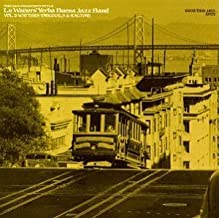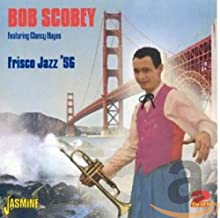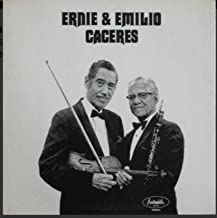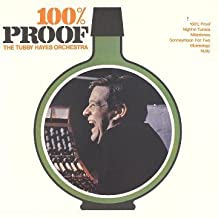
Daily Dose Of Jazz…
Lucius Carl Watters was born on December 19, 1911 in Santa Cruz, California and raised in Rio Vista, California. At St. Joseph’s military academy he belonged to the drum and bugle corps. In 1925, he moved with his family to San Francisco, California where he started a jazz band. Teaching himself how to arrange music, he found work playing trumpet on a cruise ship. He studied music at the University of San Francisco with help from a scholarship, but he dropped out of school to pursue a career.
During the Thirties, he went on tour across America with the Carol Lofner Big Band. While in New Orleans, Louisiana he became interested in traditional jazz. Back in California, he assembled jam sessions with Bill Dart, Clancy Hayes, Bob Helm, Dick Lammi, Turk Murphy, and Wally Rose. In 1938, he formed a band that included Hayes, Helm, Squire Gersh, Bob Scobey, and Russell Bennett. The band found steady work at Sweet’s Ballroom in Oakland, California and slipped in pieces of traditional New Orleans jazz into the repertoire until Watters was fired.
1939 saw Lu established the Yerba Buena Jazz Band to revive the New Orleans jazz style of King Oliver. He brought in pianist Forrest Browne, who taught the band music by Jelly Roll Morton. He wrote music and arrangements to add to the traditional repertoire. World War II interrupted their performing and he joined the Navy. After the war they reunited and started playing at different clubs and backing visiting musicians Kid Ory, James P. Johnson, and Mutt Carey.
In 1950 the band broke up and Watters left music. He became a carpenter, cook, and a student of geology. Coming out of retirement in 1963 he performed with Murphy at an anti-nuclear protest in California to prevent a nuclear plant from being constructed at Bodega Bay. He recorded an album for Fantasy with Rose, Helm, Bob Mielke, and Barbara Dane. It included the title track and another song named for the San Andreas Fault, which was consistent with his interest in geology.
Trumpeter and bandleader Lu Watters, who had a mineral from California named wattersite in his honor, passed away on November 5, 1989 in Santa Rosa, California at age 77.
More Posts: bandleader,history,instrumental,jazz,music,trumpet

Daily Dose Of Jazz…
Robert Alexander Scobey Jr. was born on December 9, 1916 in Tucumcari, New Mexico and began his career playing in dance orchestras and nightclubs in the 1930s. By 1938 he was working as second trumpeter for Lu Watters in the Yerba Buena Jazz Band. By 1949, he was leading his own band under the name Bob Scobey’s Frisco Band.
In the Fifties the group continued to play a three-year residency at the Victor & Roxie’s, growing their popularity. Clancy Hayes joined the band to sing, play banjo and contributed his own compositions such as Huggin’ and a Chalkin’. The collaboration recorded over two hundred tracks until he left in 1959 to follow a solo career.
The Frisco Band broadcasted in 1952 and 1953 on Rusty Draper’s television show. In 1953, Louis Armstrong sang with them at the Pasadena Civic Auditorium. From 1954-57, blues singer Lizzie Miles recorded and toured with the band.
In 1955, Scobey and his band played dates at San Quentin Prison and at the Rancho Grande in Lafayette, California. Two years later he recorded for Verve Records and RCA Victor, and on the latter Bing with a Beat recorded with Bing Crosby in 1957. From early in 1956, he toured colleges and universities and, in 1958, he recorded many of the student favorites and released the album College Classics.
While touring in 1960, he was reportedly drinking half and half or heavy cream to ease the pain in his stomach. Trumpeter Bob Scobey passed away from cancer on June 12, 1963 in Montreal, Quebec, Canada. His wife Jan posthumously produced a biography titled He Rambled!.
More Posts: bandleader,history,instrumental,jazz,music,trumpet

Daily Dose Of Jazz…
Born in Boggs, Oklahoma on December 7, 1906, George James began his career late in the 1920s, in the bands of Charlie Creath and Johnny Neal. Moving to Chicago, Illinois in 1928, he played with Jimmie Noone, Sammy Stewart, Ida Marples, Jabbo Smith, and Bert Hall.
In 1931 on into 1932 he toured with Louis Armstrong, then remained in New York City at the end of the tour. He went on to join the Savoy Bearcats and, later, Charlie Turner’s Arcadians. Fats Waller assumed leadership of the Arcadians in the middle of the decade, and James played under him until 1937.
Finishing the Thirties decade playing in the Blackbirds Revue, in the early 1940s George worked with James P. Johnson, Benny Carter, Teddy Wilson, and Lucky Millinder. He led his own band in 1943-44 and later in the decade he played with Claude Hopkins and Noble Sissle.
He was active both as a leader and a sideman into the 1970s, playing with Clyde Bernhardt and the Harlem Blues and Jazz Band in that decade. Saxophonist, clarinetist, and flautist George James passed away on January 30, 1995 in Columbus, Ohio.
More Posts: bandleader,clarinet,history,instrumental,jazz,music,saxophone

Daily Dose Of Jazz…
Ernesto Caceres was born on November 22, 1911 in Rockport, Texas and learned to play the clarinet, guitar, alto and baritone saxophone. He first played professionally in 1928 in local Texas ensembles. He and his brother Emilio moved to Detroit, Michigan before moving to New York City, taking work as session musicians. In 1937 they made live nationwide appearances on Benny Goodman’s popular radio series Camel Caravan which created a sensation and made them jazz stars.
In 1938 Ernesto became a member of Bobby Hackett’s band, then worked as a sideman with Jack Teagarden and Glenn Miller’s orchestra from 1940 to 1942. While with Miller, he made an appearance in the films Sun Valley Serenade and Orchestra Wives. Time with Benny Goodman, Woody Herman, and Tommy Dorsey followed later in the 1940s. In 1949 he put together his own quartet, playing at the Hickory Log in New York. He was a frequent performer with the Garry Moore Orchestra on television.
At the beginning of the 1960s he played with the Billy Butterfield Band. In 1964 he moved back to Texas and played in a band with brother Emilio from 1968 until his death. He spent some time in 1965 and 1966 at Mint Hotel in Las Vegas, Nevada and at the Holiday Hotel in Reno, Nevada with the Johnny Long Band. Saxophonist, clarinetist and guitarist Ernesto Caceres passed away from cancer on January 10, 1971.
More Posts: bandleader,clarinet,guitar,history,instrumental,jazz,music,saxophone

Daily Dose Of Jazz…
Edward Thomas Harvey was born on November 15, 1925 in Blackpool, England, but grew up in Sidcup, where he attended Chislehurst and Sidcup Grammar School. At the age of 16, he began studying engineering in nearby Crayford and took his first professional job as a musician playing trombone with George Webb and his Dixielanders, a pioneering UK traditional jazz band.
After the World World War II, Harvey joined Freddy Randall and also began performing at Club Eleven in London, England with a number of young musicians, among them Ronnie Scott and John Dankworth who were beginning to experiment with the bebop style that they had picked up from US musicians like Charlie Parker and Dizzy Gillespie.
When the Dankworth Seven formed in 1950, Harvey was a founder member and the percussionist vocalist Frank Holder was also featured in this group. He stayed until 1953, performing on both piano and trombone, and spent the 1950s performing and recording with a number of important UK jazz groups including bands led by Tubby Hayes, Vic Lewis, Don Rendell, and Woody Herman. He also began arranging for groups like Jack Parnell’s Orchestra.
From 1963 to 1972 Eddie was pianist with the Humphrey Lyttelton band. During that time of the early 1970s he also became interested in teaching jazz. His jazz piano course at the City Lit was one of the first jazz education courses in Europe. This led to his writing Teach Yourself Jazz Piano, which was published in the Teach Yourself series. After ten years teaching Music at Haileybury College in Hertfordshire, he accepted the newly created role of Head of Jazz at the London College of Music. Later teaching posts included the Guildhall and Royal Colleges of Music.
Pianist, trombonist, arranger and educator Eddie Harvey, who never led a recording session but was the inspiration for the Richmond Canoe Club Walking Division, passed away on October 9, 2012.



